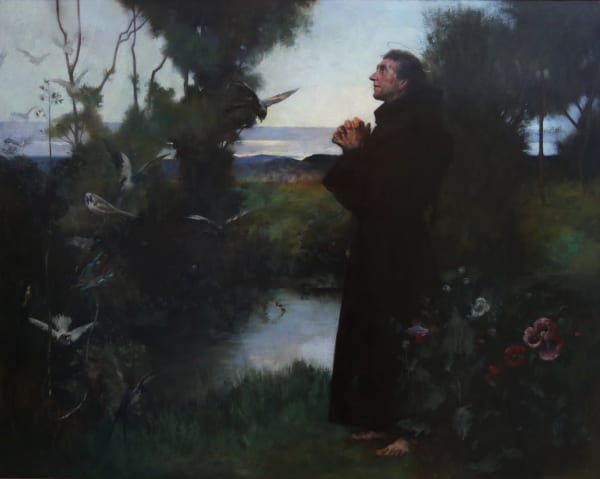Albert Chevallier Tayler 1862-1925
Tayler returned from Laurens Atelier in Paris aged 22 and arrived in Newlyn in 1884 where he was soon at the heart of the artists’ burgeoning colony. A renowned painter of the human figure, Tayler progressed from Newlyn social realist subject matter to historical and religious paintings, often on a grand scale. An avid cricketeer, his painting of Kent vs Lancashire, sold in 2006 for £680,000, a record price for a cricket painting by any artist.
Albert Chevallier Tayler was born in Leytonstone, Essex on 5 April, 1862. He was the seventh of eight children and the son of a lawyer, William Moseley Tayler and his wife, Elizabeth Sarah (née Warren). Albert was educated at All Saints’ Grammar School, Bloxham, Oxfordshire, and began to study art in London at Heatherley’s School of Art. Later he attended the Royal Academy schools before he won a scholarship to the Slade, where he befriended Thomas Cooper Gotch.
As a young man and aspiring artist, Tayler like so many of his soon to be contemporaries in Newlyn, travelled to Paris where he studied at Laurens Atelier. There he drew upon the influence of the new generation of en plein-air French natural realists and established a friendship with Norman Garstin.
Tayler returned from Paris aged 22 and arrived in Newlyn in 1884 where he was soon at the heart of the artists’ burgeoning colony. He lived in Newlyn for 12 years successively at Belle Vue House, the Malt House with the Gotches, and later at Park Terrace. In 1887 a London dealer paid for him to go and paint in Venice. He converted to Catholicism that same year returning to Newlyn in 1888.
During Tayler’s Newlyn period he initially produced social realist scenes en plein-air absorbing his Parisian training and drawing upon the influence of his Newlyn associates. Tayler was a particular exponent of the ‘square brush technique’ adopted by many of his Newlyn contemporaries in response to their experience of the Brittany artists’ colonies and the teaching of Jules Bastien-Lepage. The technique involves painting with a flat paintbrush, laying the paint on the canvas straight from the palette using the square edge of the brush. The technique achieves a natural layering of light and colour and the softened brush edges, a sense of atmosphere.
But as time progressed a preference for more harmonious and often luxuriant interior scenes became evident. Chevallier Tayler was particularly gifted in painting human subjects, both contemporary and historical. His interior scenes included dinner parties and domestic celebrations, and their high degree of finish and the artist’s painterly finesse with the human form and often complex costumes, became the source of much contemporary admiration. A typical painting of this period is ‘A Dress Rehearsal’ (1888), acquired by the National Museums Liverpool from Lord Leverhulme's private collection in 1922, and now in the Lady Lever Art Gallery.
During the 1890s he maintained connections with the art centre of London and exhibited regularly at the Royal Academy. In 1895 he served on the provisional committee of artists when Newlyn Art Gallery, opened on 22 October 1895, but soon after moved to London settling in Kensington, where he concentrated more on religious subject matter and portraiture; later becoming a Royal Academician. Despite non-residence in Cornwall, Tayler continued to show and sell paintings at the Newlyn Art Gallery. In 1896 he married Mrs Elizabeth Cotes, the daughter of a surgeon to the Royal Household, who had one daughter by her first marriage. Together the couple had two sons, both of whom were sadly killed in WWI.
At the turn of century Tayler began painting more grandiose historical scenes. In 1901 he painted one of his most ambitious works, ‘The Ceremony of the Garter’, depicting the 1348 scene at Eltham Palace when the fallen garter of Joan of Kent is rescued by King Edward III; leading to the founding the Order of the Garter. By 1903 Tayler was renowned for such works and was commissioned to paint a large panel at the Royal Exchange in London; the resultant painting of The Five Kings depicts Kings Edward III of England, David of Scotland, Peter I of Cyprus, John of France and Waldemar IV of Denmark partaking in a feast hosted by the Master of the Society of Vintners in London in 1363.
Tayler was a keen and able cricketer, and in 1905 produced a set of twelve watercolours of famous and mostly royal cricket players. Lord Leverhulme used the series to produce lithographs and advertise his Lever Brothers soap products. The promotion proved popular, and the National Portrait Gallery, London has nine of these images hanging. In 1906 he painted a cricket match in progress, Kent vs Lancashire at Canterbury, which was commissioned by Kent. In June 2006, the county sold the painting at auction for £680,000, a record price for a cricket painting by any artist.
Albert Chevalier Tayler died on 20 December, 1925 in London. There are works by the artist in numerous national collections including Penlee Museum & Gallery, Birmingham, Bristol, Liverpool and Preston Art Galleries and the Imperial War Museum.


